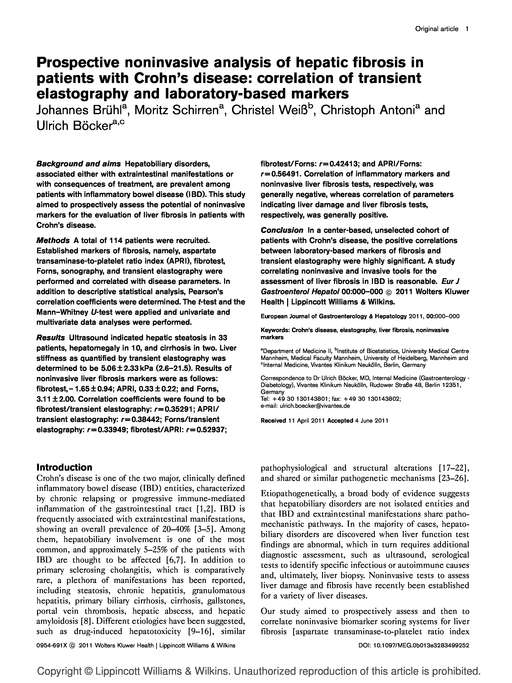Prospective noninvasive analysis of hepatic fibrosis in patients with Crohn's disease: correlation of transient elastography and laboratory-based markers.
European journal of gastroenterology & hepatology
Brühl J, Schirren M, Wei C, Antoni C, Böcker U
2011 Eur J Gastroenterol Hepatol Volume 23 Issue 10
PubMed 21814142 DOI 10.1097/MEG.0b013e3283499252
BACKGROUND AND AIMS
Hepatobiliary disorders, associated either with extraintestinal manifestations or with consequences of treatment, are prevalent among patients with inflammatory bowel disease (IBD). This study aimed to prospectively assess the potential of noninvasive markers for the evaluation of liver fibrosis in patients with Crohn's disease.
METHODS
A total of 114 patients were recruited. Established markers of fibrosis, namely, aspartate transaminase-to-platelet ratio index (APRI), fibrotest, Forns, sonography, and transient elastography were performed and correlated with disease parameters. In addition to descriptive statistical analysis, Pearson's correlation coefficients were determined. The t-test and the Mann-Whitney U-test were applied and univariate and multivariate data analyses were performed.
RESULTS
Ultrasound indicated hepatic steatosis in 33 patients, hepatomegaly in 10, and cirrhosis in two. Liver stiffness as quantified by transient elastography was determined to be 5.06±2.33 kPa (2.6-21.5). Results of noninvasive liver fibrosis markers were as follows: fibrotest,-1.65±0.94; APRI, 0.33±0.22; and Forns, 3.11±2.00. Correlation coefficients were found to be fibrotest/transient elastography: r=0.35291; APRI/transient elastography: r=0.38442; Forns/transient elastography: r=0.33949; fibrotest/APRI: r=0.52937; fibrotest/Forns: r=0.42413; and APRI/Forns: r=0.56491. Correlation of inflammatory markers and noninvasive liver fibrosis tests, respectively, was generally negative, whereas correlation of parameters indicating liver damage and liver fibrosis tests, respectively, was generally positive.
CONCLUSION
In a center-based, unselected cohort of patients with Crohn's disease, the positive correlations between laboratory-based markers of fibrosis and transient elastography were highly significant. A study correlating noninvasive and invasive tools for the assessment of liver fibrosis in IBD is reasonable.
Citation Reference:

